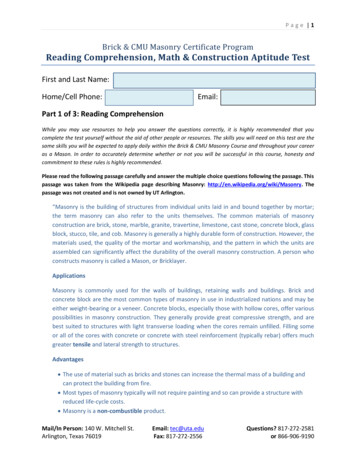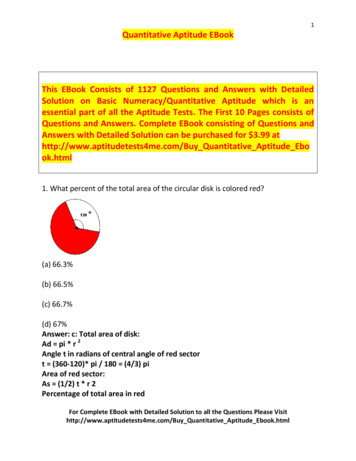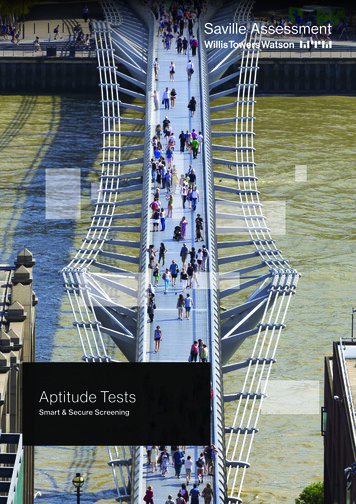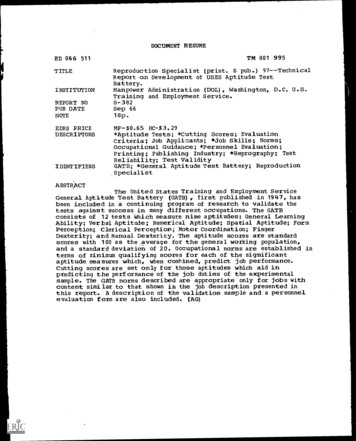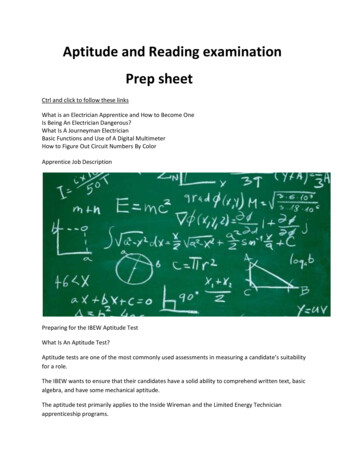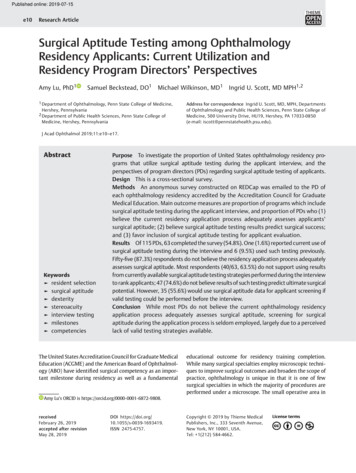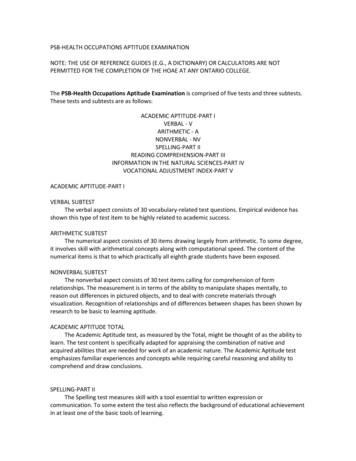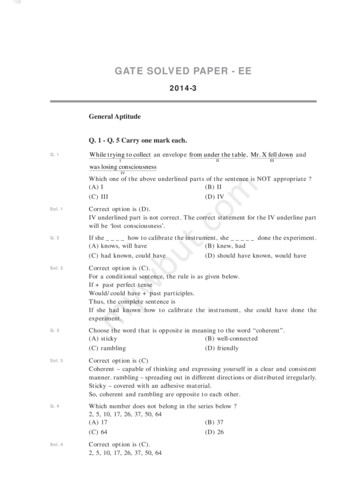
Transcription
GATE SOLVED PAPER - EE2014-3General AptitudeQ. 1 - Q. 5 Carry one mark each.Q. 1While trying to collect an envelope from under the table , Mr. X fell down andIIIIIIwas losing consciousnessIVomWhich one of the above underlined parts of the sentence is NOT appropriate ?(A) I(B) II(C) III(D) IVCorrect option is (D).IV underlined part is not correct. The correct statement for the IV underline partwill be ‘lost consciousness’.Q. 2If she how to calibrate the instrument, she done the experiment.(A) knows, will have(B) knew, hadbut.cSol. 1(C) had known, could haveCorrect option is (C).For a conditional sentence, the rule is as given below.If past perfect tenseWould/could have past participles.Thus, the complete sentence isIf she had known how to calibrate the instrument, she could have done theexperiment.Q. 3mywSol. 2(D) should have known, would haveChoose the word that is opposite in meaning to the word “coherent”.(A) sticky(B) well-connected(C) rambling(D) friendlySol. 3Correct option is (C)Coherent – capable of thinking and expressing yourself in a clear and consistentmanner. rambling – spreading out in different directions or distributed irregularly.Sticky – covered with an adhesive material.So, coherent and rambling are opposite to each other.Q. 4Which number does not belong in the series below ?2, 5, 10, 17, 26, 37, 50, 64(A) 17(B) 37(C) 64(D) 26Sol. 4Correct option is (C).2, 5, 10, 17, 26, 37, 50, 64
GATE SOLVED PAPER - EE2014-3The difference between successive terms is in AP with initial term 3 and thecommon difference 2. With this logic 64 is the wrong term and the correct numberin place of 64 is 65.Q. 5The table below has question-wise data on the performance of students in anexamination. The marks for each question are also listed. There is no negative orpartial marking in the examination.Q. No.MarksAnswered Correctly Answered WronglyNot Attempted122117623152723223183What is the average of the marks obtained by the class in the examination ?(A) 1.34(B) 1.74Sol. 5(D) 3.91om(C) 3.02Correct option is (C).Total students in class 44Total marks scored by class 21 # 2 15 # 3 23 # 2t.c 42 45 46 3.02ywbu 133Average marks Total marksTotal students 13344Q. 6 - Q. 10 Carry two marks each.A dance programme is scheduled for 10.00 a.m. Some students are participatingin the programme and they need to come an hour earlier than the start of theevent. These students should be accompanied by a parent. Other students andparents should come in time for the programme. The instruction you think thatis appropriate for this is(A) Students should come at 9.00 a.m. and parents should come at 10.00 a.m.(B) Participating students should come at 9.00 a.m. accompanied by a parent,and other parents and students should come by 10.00 a.m.(C) Students who are not participating should come by 10.00 a.m. and theyshould not bring their parents. Participating students should come at 9.00a.m.(D) Participating students should come before 9.00 a.m. Parents who accompanythem should come at 9.00 a.m. All others should come at 10.00 a.m.mQ. 6Sol. 6Correct option is (B).(i) Dance program is scheduled for 10 a.m.(ii) Participating student should come at 9 a.m. accompanied by a parent.(iii) non-participating student should come at 10 a.m. with their parents.Combining these three instructions (B) option is most appropriate.
GATE SOLVED PAPER - EEQ. 72014-3By the beginning of the 20 th century, several hypotheses were being proposed,suggesting a paradigm shift in our understanding of the universe. However, theclinching evidence was provided by experimental measurements of the position ofa star which was directly behind our sun. Which of the following inference(s) maybe drawn from the above passage ?(i) Our understanding of the universe changes based on the positions of stars(ii) Paradigm shifts usually occur at the beginning of centuries(iii) Stars are important objects in the universe(iv) Experimental evidence was important in confirming this paradigm shiftSol. 7(A) (i), (ii) and (iv)(B) (iii) only(C) (i) and (iv)(D) (iv) onlyCorrect option is (D).(i) Clinching evidence was provided by experimental measurement of position ofstar.om(ii) Our understanding of universe changes, so experimental evidence areimportant.So, by these (iv) is correct option.The Gross Domestic Product (GDP) in Rupees grew at 7% during 2012-2013.For international comparison, the GDP is compared in US Dollars (USD) afterconversion based on the market exchange rate. During the period 2012-2013 theexchange rate for the USD increased from Rs. 50/ USD to Rs. 60/USD. India’aGDP in USD during the period 2012-2013.(A) increased by 5%(B) decreased by 13%(C) decreased by 20%(D) decreased by 11%Sol. 8Correct option is (D).Let GDP in 2011-12 be xGDP in 2012-13 is 1.07x (7% grew)During 2012-13 exchange rate increase from Rs. 50/USD to Rs.60/USD.So, GDIP in comparison to USD is obtained asat initial of 2012-13 GDP/USD x50and at final 2012-13 GDP/USD 1.07x60mywbut.cQ. 8So,increase and decrease 1.07x60- 50xx50# 100% 10.83% 11%Q. 9The ratio of male to female students in a college for five years is plotted in thefollowing line graph. If the number of female students in 2011 and 2012 is equal,what is the ratio of male students in 2012 to male students in 2011 ?
GATE SOLVED PAPER - EE2014-3(B) 2 : 1(D) 2.5 : 1(A) 1 : 1(C) 1.5 : 1Correct option is (C).Let number of female students in 2011 be x .So,Number of male students in 2011 x (ratio is 1)Number of female students in 2012 x (Given)Number of male students in 2012 1.5x (ratio is 1.5)Ratio of male students in 2012 to male students in 2011 is 1.5x 1.5 : 1xConsider the equation 7526h8 - Y h8 4364h8 , where X hN stands for X to thebase N . Find Y .(B) 1737(A) 1634(C) 3142(D) 3162buCorrect option is (C).Given equation isywSol. 10 7526h8 - Y h8 4364h8or Y h8 7526h8 - 4364h8Octal subtraction is done in same way as decimal subtraction. The only differenceis that while obtaining carry we get 8 instead of 10. 7526h8- 4364h8 3142h8mQ. 10t.comSol. 9END OF THE QUESTION PAPER
GATE SOLVED PAPER - EE2014-3Electrical EngineeringQ. 1 - Q. 25 Carry one mark each.Q. 1Two matrices A and B are givenpA rbelow :qp2 q2 pr qs; B HHspr qs r2 s2If the rank of matrix A is N , then the rank of matrix B is(A) N/2(B) N - 1(C) N(D) 2NCorrect option is (C).pA randqsHomGiven the two matrices,p2 q2 pr qsB Hpr qs r2 s2but.cTo determine the rank of matrix A, we obtain its equivalent matrix using theoperation, a2i ! a2i - a21 a1i asa11pqA 0 s - r q Hps- r q 0pywIforps - rq 0then rank of matrix A is 1, otherwise the rank is 2.Now, we have the matrixmSol. 1p2 q2 pr qsB Hpr qs r2 s1To determine the rank of matrix B , we obtain its equivalent matrix using theoperation, a2i ! a2i - a21 a1i asa11VR 22pr qsWSp q2Wprqs hB S r2 s2h - 2S 02 Wp q WSXT2 pr qs hIf ps - rq h2 0 r2 s2h - 22p qorps - rq 0then rank of matrix B is 1, otherwise the rank is 2.Thus, from the above results, we conclude thatIf ps - rq 0 , then rank of matrix A and B is 1.If ps - rq ! 0 , then rank of A and B is 2.i.e. the rank of two matrices is always same. If rank of A is N then rank of Balso N .
GATE SOLVED PAPER - EE2014-3Q. 2A particle, starting from origin at t 0 s , is traveling along x -axis with velocityv p cos a p t k m/s22At t 3 s , the difference between the distance covered by the particle and themagnitude of displacement from the origin is .Sol. 2Correct answer is (C).Given the velocity of particle,v p cos pt22Since, the velocity of the particle is along x -axis. So, we havev dxdtTherefore, the displacement of the particle from t 0 (origin) to t 3 ist 3t 3p cos p tdtx # vdt #2t 0t 0 2om 6sin p2 t @0p 3t.c - 1or x 1i.e. the magnitude of displacement is 1.Now, we have to determine the distance covered by the particle. For calculatingdistance, we have to consider speed and speed can’t be negative, so the distanceis given by#t 3 #t 3ywbux0 t 0v dtp cos p t dt22p cos p t - t 3 p cos p tdt#t 1 2 22t 0 21t 3 9sin p tC - 9sin p tC2 t 02 t 1 mt 0#t 1 1 - - 1 - 1h 3Thus, the difference between the distance covered and magnitude of displacementisDx x 0 - x 3 - 1 2Q. 3Sol. 3Let d : f v h x2 y y2 z z2 x , where f and v are scalar and vector fieldsrespectively. If v yi zj xk , then v : df is(B) 2xy 2yz 2zx(A) x2 y y2 z z2 x(C) x y z(D) 0Correct option is (A).Given the relation.(i)d : f v h x2 y y2 z z2 xwhere f , v are scalar and vector field respectively. From the properties of vectorfield, we haved : f v h v : df h - f d : v h
GATE SOLVED PAPER - EE2014-3v : df h d : f v h f d : v horAgain, we have.(ii)v yi zj xkd:v So,2y 2z 2x 2x 2y 2z 0Therefore, we getf d : v h 0Substituting it in equation (ii), we getv : df h d : f v hv : df h x2 y y2 z z2 xThus,Correct answer is 0.43.Given that the life time of an electric bulb is a random variable with density,f x h kx2 .where x is the lifetime measured in years.From the property of random variable, we havet.cSol. 4Lifetime of an electric bulb is a random variable with density f x h kx2 , where xis measured in years. If the minimum and maximum lifetimes of bulb are 1 and 2years respectively, then the value of k is .omQ. 4[from equation (i)]#f x h dx 13bu-3ywSince, the minimum and maximum lifetimes of bulbs are 1 and 2 years respectively.So, we have1#x#2Therefore, equation (i) becomesmororor#2f x h dx 1#211kx2 dx 13 2k :x D 13 1kb 8 - 1 l 13k 3 0.437A function f t h is shown in the figure.Thus,Q. 5The Fourier transform F wh of f t h is
GATE SOLVED PAPER - EE2014-3(A) real and even function of w(B) real and odd function of w(C) imaginary and odd function of w(D) imaginary and even function of wCorrect option is (A).We have the waveform of function f (t) asomSol. 5From the waveform, we observe that f (t) is an odd function, i.e.f (- t) - f (t)Hence, the Fourier transform of the function is imaginary.t.cThe line A to neutral voltage is 10 15c V for a balanced three phase star connectedload with phase sequence ABC . The voltage of line B with respect to line C isgiven by(A) 10 3 105c V(B) 10 105c VbuQ. 6(C) 10 3 - 75c VywCorrect option is (C).We sketch the phasor diagram for three phase star connected load asmSol. 6(D) - 10 3 90c VSince, line A to neutral voltage isA 10 15c VSo, for balance 3-phase, we haveB 10 - 105candC 10 - 225cTherefore, the voltage of line B with respect to line C isvBC vB - vC 10 - 105c - 10 - 225c 10 3 - 75c
GATE SOLVED PAPER - EE2014-3Q. 7A hollow metallic sphere of radius r is kept at potential of 1 Volt. The totalelectric flux coming out of the concentric spherical surface of radius R r h is(B) 4pe 0 r2(A) 4pe 0 r(D) 4pe 0 R2(C) 4pe 0 RSol. 7Correct option is (A).According to Gauss’s law, the total electric flux coming out of the concentricspherical surface is equal to the charge enclosed by the surface, i.e.Q # D : dsSince, the electric potential is defined asQv 4pe 0 rQ v # 4pe 0 r 4pe 0 rSo,# D : ds 4pe rHence,0omThe driving point impedance Z s h for the circuit shown below ist.cQ. 8(since, v 1 volt)buyw42(B) s 22s 4s 23(D) 4 s 2 1s s 1mSol. 842(A) s 3 3s 1s 2s2(C) 4 s 2 1s s 1Correct option is (A).We have the impedance circuit,The capacitor and inductor can be replaced with its equivalent reactance (infrequency domain) as shown below.So, we have the equivalent circuit as
GATE SOLVED PAPER - EE2014-3Solving the above circuit, we get the equivalent driving point impedance asZ s h s 1 bs 1 lss2 s 1 b s 1 lss1 s2 1# s s s1 s2 1ss2 s s3 1s 2s42Z s h s 3 3s 1s 2sorQ. 9A signal is represented byt.c(B) 42 sin a w k2w(D) 42 sin2 wwywbu1, t 1x (t ) *0, t 1The waveform for the given signal is drawn asmSol. 9(A) 42 sin a w k sin 2wh2w(C) 42 sin 2whwCorrect option is (A).Given the signal,om1t 1x t h *0t 1The Fourier transform of the convolved signal y t h x 2t h * x t/2h isSince, the waveform of rectangular function rect (t ) isSo, comparing the two waveforms, we getx (t ) rect a t k2Now, the Fourier transform pair for rectangular function isrect c t m * t sin C c wt mt2pso,rect b t l * 2 sin C c w m 2 sin w2pw
GATE SOLVED PAPER - EESimilarly,2014-34 sin 2wh 2 sin 2wh w2wsin w/2hrect (t ) * sin C c w m 2pw/2rect c t m * 4 sin C b 2w l p4andTherefore, we have the fourier transformsF "x (2t), F "rect (t ),sin w/2h w/22 sin (2w)wThus, we obtain the fourier transform of signal y (t ) asandF {x (t/2)} F {rect (t/4)} Sol. 10For the signal f t h 3 sin 8pt 6 sin 12pt sin 14pt , the minimum samplingfrequency (in Hz) satisfying the Nyquist criterion is .t.cQ. 10omF {y (t )} F {x (2t) * x (t/2)} F {x (2t)} .F {x (t/2)}sin w/2h 2 sin (2w) ww/2 42 sin b w l sin (2w)2wCorrect answer is 14 Hz.Given the signal,buf t h 3 sin 8pt 6 sin 12pt sin 14ptAccording to Nyquist criterion the sampling frequency isywf s 2f maxwhere fmax is the maximum frequency of the message signal. For the given signal,we have maximum frequency asmw max 14por2pf max 14porf max 7Thus, the sampling frequency isfs 2 # 7orfs 14i.e. minimum sampling frequency is 14 Hz.Q. 11In a synchronous machine, hunting is predominantly damped by(A) mechanical losses in the rotor(B) iron losses in the rotor(C) copper losses in the stator(D) copper losses in the rotorSol. 11Correct option is (D).After sudden change of the load in three phase synchronous machine, the rotorhas to search or hunt for its new equilibrium position. It causes the hunting,which can be damped by rotor copper losses.Q. 12A single phase induction motor is provided with capacitor and centrifugal switchin series with auxiliary winding. The switch is expected to operate at a speed of0.7 Ns, but due to malfunctioning the switch fails to operate. The torque-speedcharacteristic of the motor is represented by
2014-3Correct answer is (C).If the switch operates correctly, then the torque-speed characteristic ismywSol. 12but.comGATE SOLVED PAPER - EEBut, the switch does not operate due to malfunctioning. So, there will be nodiscontinuity in the characteristic curve. Thus, we have the modified characteristiccurve of the motor asQ. 13The no-load speed of a 230 V separately excited dc motor is 1400 rpm. Thearmature resistance drop and the brush drop are neglected. The field current iskept constant at rated value. The torque of the motor in Nm for an armaturecurrent of 8 A is .
GATE SOLVED PAPER - EESol. 132014-3Correct answer is 12.55 N-m.A dc motor circuit is shown below.GivenNo load speed,N 1400 rpmIa 8 AV 230 VSo, we obtain the torque of the motor ast V Ia 2pV Iaw60 # N 2p230 # 860 # 1400 9.55 # 230 # 81400t.comArmature current,Excitation voltage, 12.55 N-mIn a long transmission line with r , l , g and c are the resistance, inductance,shunt conductance and capacitance per unit length, respectively, the condition fordistortionless transmission is(A) rc lg(B) r l/cCorrect option is (A).For a transmission line to be distortionless, the required condition isR GLCmSol. 14(D) g c/lyw(C) rg lcbuQ. 14G shunt conductance (in siemens/meter)C capacitance (in Farad/meter)R Resistance (in ohm/meter)L inductance (in henries per meter)So, for the given parameters of long transmission line, the required condition fordistortionless transmission becomesr gclwhereorQ. 15rc lgFor a fully transposed transmission line(A) positive, negative and zero sequence impedances are equal(B) positive and negative sequence impedances are equal(C) zero and positive sequence impedances are equal(D) negative and zero sequence impedances are equal
GATE SOLVED PAPER - EE2014-3Correct option is (B).A fully transposed transmission line is completely symmetrically and thereforethe phase impedance offered by it is independent of phase sequence of a balancedset of current. In other word impedance offered by it to positive and negativesequence currents are equal.Q. 16A 183 bus power system has 150 PQ buses and 32 PV buses. In the general case, toobtain the load flow solution using Newton-Raphson method in polar coordinates,the minimum number of simultaneous equations to be solved is .Sol. 16Correct answer is 332.Given,number of PQ buses 150number of PV buses 32For PQ buses, 2 equations are formed (one for P and other for Q)For PV buses only 1 equation is formed (for Q only)Thus, the minimum number of simultaneous equations, required to obtain theload, isTotal number of equations Number of equation for PQ buses omSol. 15Number ofequation for PV buses.t.c 2 # (number of PQ buses) 1 # (number of PV buses)The signal flow graph of a system is shown below. U s h is the input and C s h isthe output.mywQ. 17bu 2 # (150) 1 # (32) 332Assuming, h1 b1 and h 0 b 0 - b1 a1 , the input-output transfer function,C s hof the system is given byG s h U s h(B) G s h 2 a1 s a 0(A) G s h 2 b 0 s b1s b1 s b 0s a 0 s a1(C) G s h Sol. 17b1 s b 0s 2 a1 s a 0(D) G s h Correct option is (C).We have the signal flow graph of the system asa 0 s a1s 2 b 0 s b1
GATE SOLVED PAPER - EE2014-3omNow, we have to obtain the transfer function,C s hG s h U s hFrom the SFG, we have two forward paths given asp1 h 0 1 1 1 1 1 h20s ssp 2 h1 1 1 h1ssThe graph determinant is given bybut.cT 1 - (sum of all loop gains) (sum of all gain products of 2 non-touching loops)- (sum of all gain products of 3 non-touching loops) .So,T 1 - a - a1 - a2 0 kss 1 a1 a20ssAlso, we have the determinants for the forward paths p1 and p2 asywT1 1mT 2 1 - a - a1 k 1 a1ssThus, using Mason’s gain formula, we obtain the transfer function as/ p k D k p1 D 1 p 2 D 2T.F. DDh 0 1 h1 1 a12 hsask s1 a1 a20ssh 0 h1 s a1h 2s a1 s a 0Since, we haveh1 b1andh 0 b 0 - b 1 a1Substituting it in equation (i), we getT.F. orG s h b 0 b1 ss a1 s a 02C s h 2 b 0 b1 sV s hs a1 s a 0
GATE SOLVED PAPER - EEQ. 182014-3A single-input single output feedback system has forward transfer function G s hand feedback transfer function H s h. It is given that G s h H s h 1. Which ofthe following is true about the stability of the system ?(A) The system is always stable(B) The system is stable if all zeros of G s h H s h are in left half of the s -plane(C) The system is stable if all poles of G s h H s h are in left half of the s -plane(D) It is not possible to say whether or not the system is stable from theinformation givenSol. 18Correct option is (A).For the given system, we haveG s h H s h 1So, we may easily conclude that the Nyquist-plot intersect the negative real axisbetween 0 and - 1 point, i.e. the Nyquist plot does not enclose the point - 1, 0hor in other words number of encirclements is zero.omN 0From Nyquist criterion, we have the relation.(i)but.c.(ii)N P-Zwhere P is the number of open loop poles in right-half of s -plane and Z is thenumber of closed loop poles (roots of characteristic equation) in right-half of s-plane. Since, for a stable closed loop system, we must have.(iii)Z 0Thus, from equations (i), (ii), and (iii), we getAn LPF wattmeter of power factor 0.2 is having three voltage settings 300 V, 150V and 75 V, and two current settings 5 A and 10 A. The full scale reading is 150.If the wattmeter is used with 150 V voltage setting and 10 A current setting, themultiplying factor of the wattmeter is .mQ. 19ywP 0i.e. no poles of open loop system lies in right-half of s -plane, or in other words,all the poles lies in left-half of s -plane.Hence, the given system is stable if all poles of G s h H s h are in left half of the s-plane.Sol. 19Correct answer is 2.In low power factor (LPF) wattmeter, the multiplying factor is given bypower settingM.F. power for maximum difflection voltage range usedh # current range usedh # (power factor) Full scale readingFrom the given data, we haveFull scale reading 150Voltage range used 150 VCurrent range used 10 APower factor 0.2Substituting these values in above expression, we getM.F. 150 # 10 # 0.2 2150
GATE SOLVED PAPER - EEThe two signals S1 and S2, shown in figure, are applied to Y and X deflectionplates of an oscilloscope.omQ. 202014-3mywbut.cThe waveform displayed on the screen isSol. 20Correct option is (A).We consider the two signals S1 and S2 applied to Y and X deflection plates forthe period T as
GATE SOLVED PAPER - EE2014-3A state diagram of a logic gate which exhibits a delay in the output is shown inthe figure, where X is the don’t care condition, and Q is the output representingthe state.mQ. 21ywbut.comobserving the waveforms, we condude thatFor 0 t T/2 , 0 S1 1 and S2 1At t T , S1 S2 02For T t T , 0 S1 - 1 and S2 - 12Since, S1 is applied to Y -deflection plate and S2 is applied to X -deflection plate.So, we haveFor 0 t T/2 ; 0 y 1, x 1At t T/2 ; x y 0For T/2 t T ; - 1 y 0 , x - 1Thus, the waveform displayed on the CRT screen isThe logic gate represented by the state diagram is(A) XOR(B) OR(C) AND(D) NANDSol. 21Correct option is (D).We have the state diagram of a logic gate,
GATE SOLVED PAPER - EE2014-3For the state diagram, we form the truth table (irrespective of the current state)asABX001011101110Thus, from the truth table, it is clear that the logic gate is NAND gate.An operational amplifier circuit is shown in the figure.t.comQ. 22mSol. 22ywbuThe output of the circuit for a given input vi is(A) -b R2 l vi(B) -b1 R2 l viR1R1(C) b1 R2 l vi(D) Vsat or - VsatR1Correct option is (D).We have the op-amp circuit asFor an operation amplifier, we know that1. If vi Vsat ; then output voltage will be Vsat2. If vi - Vsat ; then the output voltage will be - Vsat3. If - Vsat vi Vsat ; then the output voltage varies according to the appliedinput.For the given op-amp circuit, we assume that- Vsat vi Vsat
GATE SOLVED PAPER - EE2014-3So, we obtain the output for the corresponding input vi . Applying KCL at noninverting terminal of first op-amp, we havevi - 0 vi - x 0R1R2orvi b 1 1 l xR2R1 R 2or.(i)x b R1 R 2 l v iR1where x is the voltage at non-inverting terminal of second op-amp. Again, applyingKCL at non-inverting terminal of second op-amp, we getx - 0 x - v0 0RRv 0 2xor[substituting equation (i)]v 0 2vi R1 R2hR1 2vi b1 R2 lR1There is no single option so our assumption is wrong and vi Vsat and vi - Vsat. So, the output voltage is Vsat and - Vsat .omorIn 8085A microprocessor, the operation performed by the instruction LHLD2100 H is(A) Hh ! 21 H , Lh ! 00 H(B) Hh ! M 2100hH , Lh ! M 2101 Hh(C) Hh ! M 2101 Hh, Lh ! M 2100 Hh(D) Hh ! 00 H , Lh ! 21 HSol. 23Correct option is (C).For the 8085A microprocessor, given instruction isLHLD 2100 HThis operation loads registers register L and H with the content in memory atlocations 2100 H and 2101 H respectively, i.e.mywbut.cQ. 23 Hh ! M 2101hH and Lh ! M 2100hHQ. 24A non-ideal voltage source Vs has an internal impedance of Zs . If a purely resistiveload is to be chosen that maximizes the power transferred to the load, its valuemust be(A) 0(B) real part of Zs(D) complex conjugate of Zs(C) magnitude of ZsSol. 24Correct option is (C).Consider the circuit shown below with non-ideal voltage source Vs , an internalimpedance Zs Rs jXs , and purely resistive load RL .
GATE SOLVED PAPER - EE2014-3Current through the circuit is given byVsRs RL jXsVsI Rs RL h Xs h2I orTherefore, the power transferred to load isP I 2 RL V s2 RL Rs RL h2 X s2hFor maximum power, we havedP 0dRLor[ Rs RL h2 X s2 ] 1 - 2RL Rs RL h 02 Rs RL h2 X s2hR s2 R L2 2Rs RL X s2 - 2Rs RL - 2R L2 0omorR s2 X s2 R L2orThe torque speed characteristics of motor TM h and load TL h for two cases areshown in the figures (a) and (b). The load torque is equal to motor torque atpoints P , Q , R and S .mywbuQ. 25t.corRL R s2 X s2i.e. to maximise the power transferred to pure resistive load (RL ), its value mustbe equal to the magnitude of Zs of internal circuit.The stable operating points are(A) P and R(C) Q and RSol. 25(B) P and S(D) Q and SCorrect option is (B).Since, increase in torque accelerates the motor, so the slope of torque speedcharacteristic should be negative to restore the speed to original value, which inturn makes the system stable.Thus, for stable operating point, the slope of torque-speed characteristic shouldbe negative.Hence, the points P and S are stable operating points.
GATE SOLVED PAPER - EE2014-3Q. 26 - Q. 55 Carry two marks each.Q. 26Sol. 262Integration of the complex function f z h 2 z , in the counterclockwisez -1direction, around z - 1 1, is(A) - pi(B) 0(C) pi(D) 2piCorrect option is (C).Given the complex function,z2z -1and the contour, along which integration to be performed, isC : z - 1 1f z h 2t.comHere, z - 1 1 is a circle with radius 1 and centre at point (1,0). So, we sketchthe contour C asbuNow, we have the complex functionf z h z2z -12mywSo, the poles and zeros of the function arepoles 1, - 1zeros 0 , 0Therefore, only pole (z 1) lies within the curve C . So, the residue at z 1 poleis2Residue lim zz " 1 z 1h2 lim z 1 11 1 2z"1 z 1Thus, the integral of complex function along the contour is obtained as# f z hdzC 2pi (sum of residues) 2pi b 1 l2 piQ. 27The mean thickness and variance of silicon steel laminations are 0.2 mm and0.02 respectively. The varnish insulation is applied on both the sides of thelaminations. The mean thickness of one side insulation and its variance are 0.1mm and 0.01 respectively. If the transformer core is made using 100 such varnishcoated laminations, the mean thickness and variance of the core respectively are(A) 30 mm and 0.22(B) 30 mm and 2.44(C) 40 mm and 2.44(D) 40 mm and 0.24
GATE SOLVED PAPER - EESol. 27Q. 28Sol. 282014-3Correct option is (D).The function f x h ex - 1 is to be solved using Newton-Raphson method. If theinitial value of x 0 is taken as 1.0, then the absolute error observed at 2 nd iterationis .Correct answer is 0.06005.We have the function,f x h ex - 1So, its first derivative is obtained asf l x h exBy Newton-Raphson method, we havef xi hxi 1 xi f l xi hSince, we have the initial value,omx0 1So, we obtain the 1st iteration asf x 0hf l x 0hx1 x0 - e ex1 1 - e -1 1 e-1 .3678ex1 x 0 -0t.c0f x1hf l x1hx1 x1 - e ex x1 - 1 e-x 0.3678 - 1 e-0.3678buTherefore, the 2nd iteration isQ. 29Sol. 29mywx 2 x1 -111 .06005The Norton’s equivalent source in amperes as seen into terminals X and Y is.Correct answer is 2.To obtain the Norton equivalent along X -Y terminal, we redraw the given circuitas
GATE SOLVED PAPER - EE2014-3t.comIn the network, 5 W resistor is short-circuit. So, the equivalent circuit isNow, writing the KVL equation in two loops, we have5 - 5I1 - 5 I1 - Isc h 0- 5 Isc - I1h - 2.5Isc 2.5 0Solving equation (i),bu.(i).(ii)10I1 - 5Isc 52I1 Isc 1yw.(iii)Solving equation (ii),moror7.5Isc - 5I1 2.53Isc - 2I1 13Isc - Isc - 1 1[using equation (iii)]2Isc 2Thus,Isc 1 Ai.e. the Norton equivalent source as seen into terminals X and Y is 1 A.orQ. 30The power delivered by the current source, in the figure, is .Sol. 30Correct answer is 3 W.To obtain the required unknown, we redraw the given circuit as
GATE SOLVED PAPER - EE2014-3Applying KCL at node Vx , we haveVx - 1 Vx 2112Vx - 1 2orVx 32Therefore, the power delivered by current source is obtained asomor Voltage across current source # current throughcurrent sourcet.cmywbuQ. 31 3#2 3W2A perfectly conducting metal plate is placed in x -y plane in a right handedcoordinate system. A charge of 32pe 0 2 coulombs is placed at coordinate 0, 0, 2h. e 0 is the permittivity of free space. Assume i , j , k to be unit vectorsalong x , y and z axes respectively. At the coordinate 2 , 2 , 0h, the electricfield vector E (Newtons/Coulomb) will beSol. 31(A) 2 2 k(B) - 2k(C) 2k(D) - 2 2 kCorrect option is (D).We have the given system of a charge and a perfectly conducting metal plate asshown below.
GATE SOLVED PAPER - EE2014-3but.comDue to presence of conducting plane, we can assume an image charge for thesystem as shown belowywSo, we can observe from the figure that electric field vector along x -y planeis cancelled, i.e. zero. Therefore, the electric field vector acts along negative z-direction and given as".(i)E d E1 E2 n - kth22mwhere E1 and E2 are the field intensity due to the charge Q and - Q at point( 2 , 2 , 0). So, we obtainQ32pe 0 2E1 1 2 14pe 0 r4pe 0 ( ( 2 ) 2 ( 2 ) 2 (2) 2) 2 2Similarly, we get, E2 2Substituting these values in equation (i), we obtain"2 2 - 2ktE eQ. 322 - kto h2A series RLC circuit is observed at two frequencies. At w 1 1 krad/s , we notethat source voltage V1 100 0c V results in a current I1 0.03 31c A . Atw 2 2 krad/s , the source voltage V2 100 0c V results in a current I2 2 0c A. The closest values for R, L, C out of the following options are(A) R 50 W ; L 25 mH ; C 10 mF ; (B) R 50 W ; L 10 mH ; C 25 mF ;(C) R 50 W ; L 50 mH ; C 5 mF ;(D) R 50 W ; L 5 mH ; C 50 mF ;
GATE SOLVED PAPER - EECorrect option is (B).Given the current and voltage at different frequencies asAt w 1 1 krad /s,V1 100 0I1 0.03 31cAt w 2 2 krad /s,V2 100 0I 2 2 0cFrom the given data, it is clear that voltage and current are in phase at w 2 2 .So, it satisfies the resonance condition. Therefore, we haveR V 100 50 W2IAlso, for the resonance circuit, we havewL 1wC1or103 # 2 # L 2 # C # 103or.(i)4 # 106 L 1CAgain, at w 1 krad/s, we havec
pq prqs rs pq pr qs 0 22 22 22 2 - h h R T S S S S V X W W W W If rs pq 22 pr qs 22 2 - h h - hps rq 2 0 or ps-rq 0 then rank of matrix B is 1, otherwise the rank is 2. Thus, from the above results, we conclude that If ps rq- 0, then rank of matrix A and B is 1. If ps rq- ! 0, then rank of A and B is 2. i.e. the rank of .

